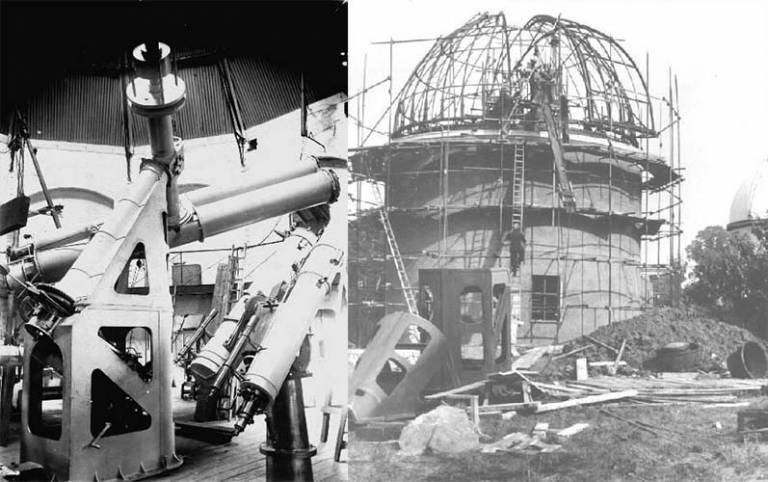The Radcliffe twin refractor was built in 1901 by Grubb of Dublin, originally for the Radcliffe observatory in Oxford. Having been offered to UCLO in 1935, it was transported and erected at this site at Mill Hill in 1938. Since then it has been mainly used for research in positional astronomy and for undergraduate teaching in practical astronomy. Since 2000, the Radcliffe has been used for photometric observations of exoplanetary transits.
The Radcliffe consists of two telescopes on a single German equatorial mount, designed and built in the days when Imperial units were standard. The larger, 24-inch (60-cm) telescope was originally used to take images on 12x12-inch glass photographic plates, for astrometry including parallax measurements. For practical reasons (including economy!) 6x6-inch plates were later used for student training, but large-format CCD detectors have been employed almost exclusively for imaging since 1994. The co-aligned 18-inch (45-cm) telescope was originally intended for 'hand-and-eye' guiding, to correct tracking errors during long photographic exposures. This is no longer important because of improved telescope control, and because of the generally shorter integrations associated with highly efficient digital detectors, but the 18-inch continues to be used for visual and video-camera observing.
The matched focal lengths of the telescopes are each nearly seven metres, and the dome which houses the Radcliffe is over 10 metres in diameter. The total weight of the tube of the telescope and the arm required to counterbalance its weight is about five tonnes, and the framework a further six.
| Built: | 1901 |
|---|---|
| Acquired: | 1938 |
| Refurbished: | 1994 |
| Optics: | Twin Grubb Refractor |
| Aperture: | 18" (45cm), 24" (60cm) [f/15, f/11.5] |
| Focal Length: | 276" (7.0m) |
| Plate Scale: | 29.5 arcsec/mm |
| Detector 24": | Apogee Alta U9000 camera (Kodak KAF-09000 3056x3056 CCD, 12x12-micron pixels) Johnson-Cousins BVR; 'comet' filters, H2O+ (620.5nm) + continuum (625.0nm) |
| Detector 18": | visual & video imaging |
| Additional Instrumentation: | N/A |
| CCD Field of view: | 18 x 18 arcmin |
| Controls: | Manual (motorised) slew with digital readouts. |
| Drive: | Electric stepper motor |
| Mount: | German Equatorial |
1994 Refurbishment
The Radcliffe was refurbished in 1994 to provide this optically excellent instrument with a pointing system under electronic control, to upgrade the old purely mechanical drive by providing additional functionality, improved accuracy, and computer control. Care has been taken to implement changes without damaging or changing the original structure, so the telescope retains the 'feel' of the original 1901 Grubb engineering.

The telescope drive was originally gravity driven and regulated by Grubb's pendulum-controlled electro-mechanical regulating system. Later, the gravity drive was replaced by a three-phase electric motor. The current system provides digital control, so tracking and positioning can now be controlled by computer, alongside other systems like the CCD imaging.
The resulting simplifications in operations have opened up use of the telescope to more students, and allow more ambitious observing projects to be attempted. The telescope can now be pointed with an accuracy of approximately ten arcseconds (rms), so that even faint, isolated targets can be reliably acquired.
Cleaning the objective lenses

 Close
Close

